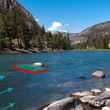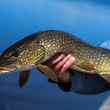One gray, chilly afternoon in late-October, I drove out to the Hickey Brothers’ place to see if they had any whitefish livers—a delicacy, found only in scattered fishing villages on the northern Great Lakes, whose fans are almost cult like in their devotion. A friend from Iowa who’d fallen under their spell was arriving to hunt grouse and woodcock and I knew he’d go weak in the knees if I told him that sauteéd whitefish livers were on the menu.
You’re probably shaking your head in disbelief at this point and wondering What is this guy smoking?, but I promise you this is legit. Similar in size and taste to chicken livers but with a milder flavor and creamier texture, whitefish livers (we’re talking lake whitefish here, Coregonus clupeaformis) are typically dusted in flour or cornmeal, pan-fried in butter or olive oil (or some of both), and served as an appetizer with sauteéd onions, bell peppers and, if the spirit moves, whatever fresh mushrooms you have on hand. Tartar sauce and wedges of lemon on the side, of course. Greunke’s Inn, the Bayfield, Wisconsin, landmark that’s generally considered the first restaurant to offer whitefish livers on its menu (this was sometime in the 1940s) serves them on toast. You can throw in a handful of smoky diced bacon, too, if you want, although you should resist the temptation to get too fancy.
With whitefish livers, less is definitely more.
Third-generation commercial fishermen of Norwegian descent, the Hickeys, Dennis and Jeff, plied the emerald waters of Lake Michigan from their home port of Baileys Harbor on the Door Peninsula—the scenic, orchard-dotted scarp that extends, like a bony tapering finger, from the Wisconsin “mainland.” (It was also where I lived at the time.) If the name Hickey rings a bell, it could be because these are the same guys who, for a while now, have been applying their gill-netting expertise to the task of removing invasive lake trout from Yellowstone Lake, the goal, of course, being to restore its population of native Yellowstone cutthroat.

It was while I was working at the Baileys Harbor Yacht Club in the mid-1980s, where in those days the Hickeys moored their tugs, that the joy of whitefish livers was revealed to me. Willy Karlheim, a German expat who was the very model of the hard-drinking, moodily temperamental but immensely talented European chef, featured them on the menu there from the day he was hired. They literally came straight from the Hickeys’ boats to his kitchen, a distance of a few hundred feet. The first time Chef Willy tilted a blackened sauté pan over an hors d’oeuvres plate and shook some livers out for me to try, I was hooked.
I often recommended them to BHYC guests in my role as maitre d’, an evangelist spreading his secret gospel. Within the first couple of bites, you could see their initial skepticism vanish, replaced by an expression of utter, and utterly unexpected, delight.
Now, I followed the narrow road that hugs the north shore of the harbor, the densely ranked cedars pressing close on both sides, the lay of the land gently cupping the water. Here and there a modest clapboard cottage, of no identifiable style, interrupted the wall of intricately textured green.
When I got to the Hickeys’, not at the end of the road but close enough to see it, I stepped out of my truck into an environment redolent of fish. I spied Dennis through the open garage-style doors of the processing building, its floor elevated so that a reefer truck could back up to it. He was hosing down a table, and he looked, in his yellow oilskin bibs, like a commercial fisherman direct from central casting: beefy and broad-shouldered, his face deeply tanned and his curly, close-cropped blond hair bleached almost white by the sun. He bore a strong resemblance to the actor Sterling Hayden, famous for his roles as a tough guy in a slew of movies in the 1950s and 60s, also as the hilariously demented General Jack T. Ripper in Dr. Strangelove.
I hollered over the noise of the hose to get his attention. “Hey,” I called up to him, “do you have any whitefish livers?”
“I don’t,” he said, hooking the handle of the spray nozzle over a peg. “There isn’t much demand right now, and with our season about to close for the whitefish spawn we’re busier than hell. It just isn’t worth our time to save them.
“But,” he added, “do you see that tub over there?”
I looked around and saw a rectangular tub, one of those heavy-duty jobs made of molded gray plastic, resting atop a picnic table at the edge of the woods.
“Uh, yeah,” I said.
“Well,” Dennis continued, “we just cleaned a bunch of whitefish, and the guts are in there. If you want to pick out the livers, help yourself. I’ll give you something to put them in. Just be sure to peel off the gall bladder—it’s the yellow sac attached to the liver, you can’t miss it—and be careful not to tear it. You don’t want the bile to spill out.”

Free whitefish livers; had I died and gone to heaven? I spent the next hour or so reaching into that tub of guts, happily separating the dark lobes of the livers from the other, um, stuff and, after following Dennis’s instructions and carefully removing the gall bladders, dropping them into the cylindrical plastic container (the kind frozen cherries come in) that he’d provided. It was dumpster-diving with a purpose…and it’s hard to explain how deeply satisfying it was. Like picking berries or mushrooms, digging clams, dip-netting smelt, or engaging in some other simple, uncomplicated harvest, it seemed to trigger an atavistic pleasure response hard-wired into the human race, the fruit of our hundreds of thousands of years of evolution as opportunistic hunter-gatherers.
In other words: We were born for this.
With a good quart-and-a-half of livers in my container—more than enough for my needs—I sealed the lid, placed it on the passenger seat of the truck so I could keep it upright with my free hand, and headed home.
My hunting buddy from Iowa arrived the following afternoon, and when I told him we’d be having whitefish livers, he nearly swooned.
As you’ve probably guessed, this all happened a while ago. Just for fun, I phoned Hickeys’ the other day—it’s now called the Baileys Harbor Fish Company—to see if they had any whitefish livers. The friendly woman who took my call told me that I had to order them at least three days in advance.
I should have asked if there’s a pick-your-own option.
































Comments
Kerry Gubits replied on Permalink
Great story! Thanks! I am a huge fan of monkfish liver (ankio in Japanese restaurants) and smoked cod liver. I used to throw the Mountain Whitefish I caught from the Elk River in Colorado in my smoker and eat them with sour cream.
Pages